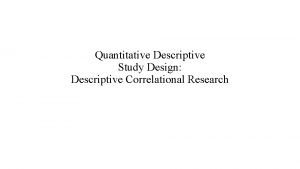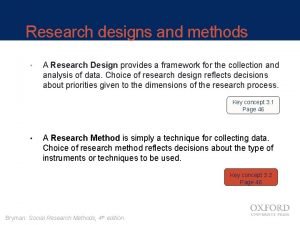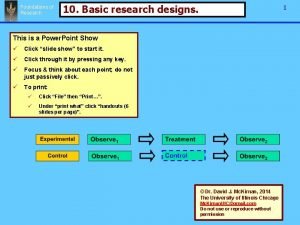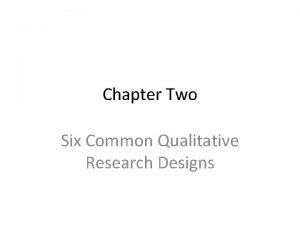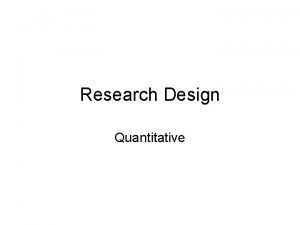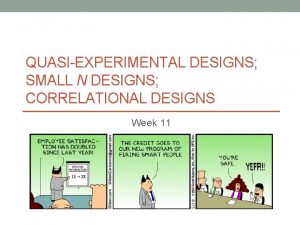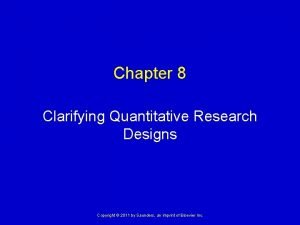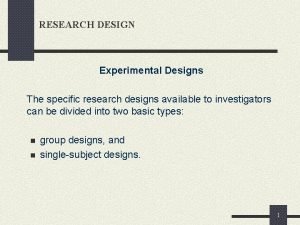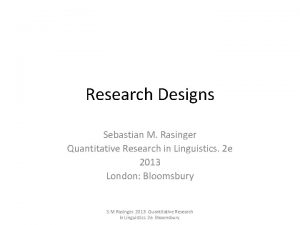Quantitative Research Designs Chapter 7 Copyright 2019 Mc

















- Slides: 17

Quantitative Research Designs Chapter 7 Copyright © 2019 Mc. Graw-Hill Education. All rights reserved. No reproduction or distribution without the prior written consent of Mc. Graw-Hill Education.

Three Forms of Quantitative Research Designs Characteristics Experimental forms Quasiexperimental forms Descriptive forms Manipulation of independent variables Present: Researcher controlled Present: Natural variation Absent Random assignment of participants to conditions Present Absent Copyright © 2019 Mc. Graw-Hill Education. All rights reserved. No reproduction or distribution without the prior written consent of Mc. Graw-Hill Education. 2

Used to determine causation Conducted in a laboratory or other simulated settings controlled by researchers The Experimental Framework Lab environment controls for extraneous influences When an independent variable is manipulated, a researcher should conduct a manipulation check In 2013, Westerman and Westerman randomly assigned participants to one of four message conditions to examine how participants responded to feedback about a work project Copyright © 2019 Mc. Graw-Hill Education. All rights reserved. No reproduction or distribution without the prior written consent of Mc. Graw-Hill Education. 3

Researcher controls Selection of treatment and control groups Based on theory Random sample Classical Experiment Random assignment of participants to conditions Ensures participants in each condition are equivalent before any treatment Manipulation checks Copyright © 2019 Mc. Graw-Hill Education. All rights reserved. No reproduction or distribution without the prior written consent of Mc. Graw-Hill Education. 4

Figure 7. 2: Posttest Only Design Jump to Figure 7. 2: Posttest Only Design, Appendix Copyright © 2019 Mc. Graw-Hill Education. All rights reserved. No reproduction or distribution without the prior written consent of Mc. Graw-Hill Education. 5

Figure 7. 3: Pretest. Posttest Experimental Design Jump to Figure 7. 3: Pretest-Posttest Experimental Design, Appendix Copyright © 2019 Mc. Graw-Hill Education. All rights reserved. No reproduction or distribution without the prior written consent of Mc. Graw-Hill Education. 6

Treatment groups based on two or more independent variables Factorial Design Allows the researcher to test for the effects of each independent variable Researchers can test for main and interaction effects Copyright © 2019 Mc. Graw-Hill Education. All rights reserved. No reproduction or distribution without the prior written consent of Mc. Graw-Hill Education. 7

Multiple measurements of the dependent variable across time Longitudinal Experimental Design Time between measurements for a design depends on the nature of the communication phenomenon being studied Helpful in determining the degree to which training or instruction has been effective Copyright © 2019 Mc. Graw-Hill Education. All rights reserved. No reproduction or distribution without the prior written consent of Mc. Graw-Hill Education. 8

Evaluating Experimental Designs Strengths Limitations • Researchers can manipulate the independent variable to observe changes in the dependent variable • Not all communication can be studied using one of the experimental forms • Assume that any effect on the dependent variable, or D V, is the cause of the independent variable I V • Precision • Cannot guarantee that some factor other than the treatment factor produced the significant effect • May not reflect reality Copyright © 2019 Mc. Graw-Hill Education. All rights reserved. No reproduction or distribution without the prior written consent of Mc. Graw-Hill Education. 9

Researcher relies upon natural variations in the independent variable Quasi. Experiments Posttest, pretest-posttest, factorial, and longitudinal designs can be used as long as the natural variation of the independent variable can be substituted for manipulation of the independent variable Field experiments are particularly effective for studying communication in context Copyright © 2019 Mc. Graw-Hill Education. All rights reserved. No reproduction or distribution without the prior written consent of Mc. Graw-Hill Education. 10

Researcher controls manipulation of the I V and random assignment of participants Field Experiments Occur in real and natural environments Allow for the observation and evaluation of complex and unfolding interaction events Copyright © 2019 Mc. Graw-Hill Education. All rights reserved. No reproduction or distribution without the prior written consent of Mc. Graw-Hill Education. 11

Strengths and Limitations of Quasi. Experimental Research Designs Strengths Limitations Can address realworld problems Conditions may not be equivalent Design is based on naturally existing variations Cannot determine cause and effect Copyright © 2019 Mc. Graw-Hill Education. All rights reserved. No reproduction or distribution without the prior written consent of Mc. Graw-Hill Education. 12

Also called cross-sectional or nonexperimental designs Researcher does not control the manipulation of the I V Descriptive Designs Participants are not randomly assigned to conditions Predictor and criterion are better labels for the I V and D V as they do not imply causality Copyright © 2019 Mc. Graw-Hill Education. All rights reserved. No reproduction or distribution without the prior written consent of Mc. Graw-Hill Education. 13

Strengths Evaluating Descriptive Designs Conducted in environments with participants who are like the individuals the researcher wants to generalize Can be used to explore topics Limitations No direct control over the manipulation of the I V Researcher does not assign participants to experimental conditions Limits interpretation of research findings Copyright © 2019 Mc. Graw-Hill Education. All rights reserved. No reproduction or distribution without the prior written consent of Mc. Graw-Hill Education. 14

Developed for experimental, quasiexperimental, and descriptive designs Online Experiments Designed as a field experiment if online behavior is the natural environment being examined Help in reaching a diverse audience of participants Can embed audio and video elements Sampling can be problematic Copyright © 2019 Mc. Graw-Hill Education. All rights reserved. No reproduction or distribution without the prior written consent of Mc. Graw-Hill Education. 15

Bias and error can be introduced through the interaction with participants Researcher Effects and Procedural Bias How a researcher communicates with participants Researcher unknowingly encourages desired responses Demand characteristics are created when a research topic has socially desirable elements Researcher uses research protocol to detail procedural steps Copyright © 2019 Mc. Graw-Hill Education. All rights reserved. No reproduction or distribution without the prior written consent of Mc. Graw-Hill Education. 16

Figure 7. 6: How Is the Study Designed? Jump to Figure 7. 6: How Is the Study Designed? , Appendix Copyright © 2019 Mc. Graw-Hill Education. All rights reserved. No reproduction or distribution without the prior written consent of Mc. Graw-Hill Education. 17
 Types of methodologies
Types of methodologies Quasi experiment disadvantages
Quasi experiment disadvantages Descriptive correlational design
Descriptive correlational design What is a research design
What is a research design What is the copyright designs and patents act 1988
What is the copyright designs and patents act 1988 Copyright designs and patents act 1988 examples
Copyright designs and patents act 1988 examples Chapter 10 qualitative research designs
Chapter 10 qualitative research designs Qualitative research designs chapter 10
Qualitative research designs chapter 10 Characteristic of
Characteristic of Nist sp 800-53 rev. 5
Nist sp 800-53 rev. 5 Instrumentation example in research
Instrumentation example in research Chapter 2 quantitative research
Chapter 2 quantitative research Categories of research design
Categories of research design Basic research designs
Basic research designs Six types of qualitative research
Six types of qualitative research Types of action research design
Types of action research design Exploratory descriptive and causal research
Exploratory descriptive and causal research Causal design example
Causal design example


